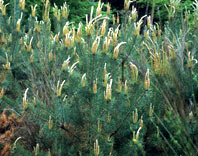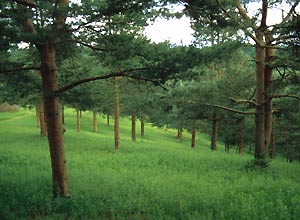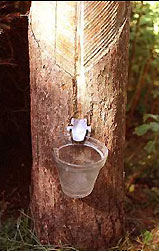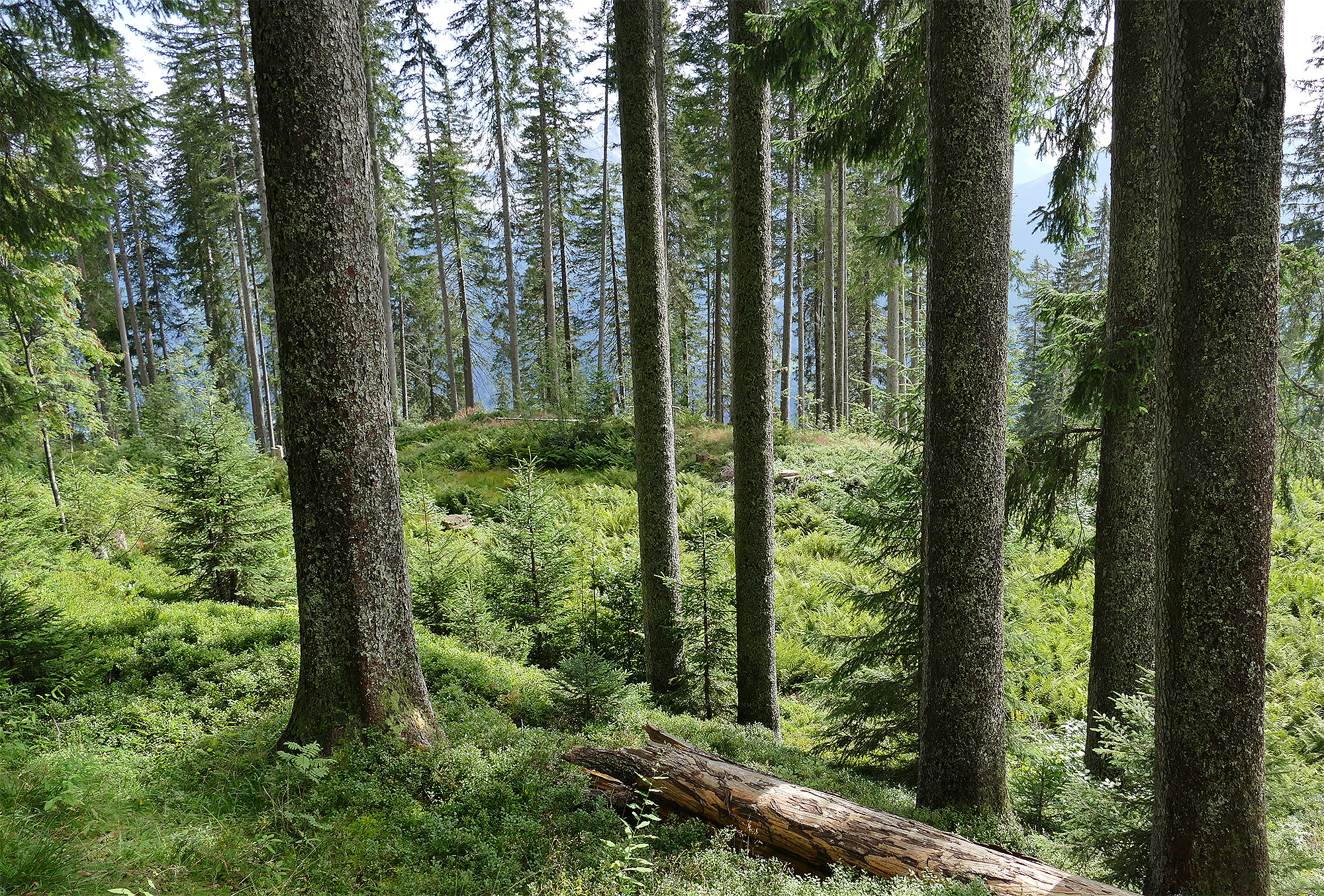The Scots pine (Pinus sylvestris L.) also known as the common pine or red fir is one of the most important tree species in Europe both economically and ecologically. It is the most well known and in central Europe, the most common species of the genus Pinus, to which more than 90 species in the northern hemisphere belong.
Its range covers all of Eurasia and stretches from the polar circle in the north to the south of Turkey and from the West of Germany to Asia in the East. There are also isolated occurrences in Scotland and the Pyrenees.
Scots pines prefer a continental climate, therefore their natural limit of spread to the west runs across Germany. The focal points of their spread are the sandy regions of Brandenburg and Mecklenburg-Vorpommern, the north western Geest-areas and the upper Rhine rift between Karlsruhe and Mainz/Frankfurt as well as the pre-Alps in Bayern.
Their altitude limit in the Alps is between 1700 and 2000 m.
Characteristics and morphological features
The Scots pine belongs to the 2 needle pines. The pairs of needles remain on the tree for 3-4 years and reach a length of 2.5 to 7 cm. Their colour ranges from yellow/green to blue/green depending on location. Pine trees can reach 35 m. If growing in good locations they can even reach 40 m in height. The bark has a characteristic reddish- brown colour which is also known as mirroring bark, as it sometimes reflects sunlight. Pine trees can reach an age of 800 to 1000 years.
Flowers

Fig. 1: Pine flowers.
Scots pine are monoecious, i.e. female and male flowers are produced on the same tree. The male flowers are yellow, the female reddish, inconspicuous and only recognisable as flowers under closer observation. They blossom in May/June and the seeds ripen in the cones in September/October of the following year.
Crown
The crowns of fully grown Scots pines are often asymmetrical, distinctly irregular, at the top umbrella like and have a southern appearance.
Root system
The root system is also very varied. On deep loose soil they produce tap roots; on heavy clay soil a compact fibrous root system and a well branching, flat laying root system on shallow soil e.g. rocky soil
Habitus
The trunk form of the pine tree also varies depending on its origin. In the upper regions of the northern Black Forest there are occurrences of markedly straight forms, the so called "Black Forest pine". In the south west of Germany however, they are much shorter and have a bent form. There are also many varieties which having adapted themselves to certain locations only occur there e.g. the Scottish wood pine (Scots pine var. Scotica), the Lapland pine (var. Laponica) or the Engadine wood pine (var. engadinsis) (HEDKER 1985).
Importance

Fig. 2: Pine seed plantation in Liliental (Kaiserstuhl).
The Scots pine is a much sought after tree from an economic point of view. They make up around 24% of forest cover in Germany, which corresponds to an area of about 2.5 million hectares (BMVEL, 2004), making it the second most common tree after the Norwegian spruce. After the last ice age pine trees together with birch trees took over most of central Europe. The open landscape and the virgin soil provided ideal conditions for them as pioneer species. This provided the basis around 8000 years ago, for the spread of other deciduous trees. However, because the pine is a shade intolerant species it could not compete with stronger deciduous trees, such as the beech tree and was mainly pushed back onto locations which were poor in nutrients, very dry or boggy. Optimal growing conditions are to be found however on clayey sand or sandy clay.
Towards the end of the middle ages the pine started to be planted artificially over large areas. Due to the fact that the pine tree is not demanding in nutrient and water needs it was ideal for depleted soils. Most of the areas covered by pine trees are not natural forests but have been planted. Information about the used stock is only rarely available. Due to its tolerance of drought and high temperatures the pine will most likely increase in importance in view of the climate change. In Baden-Württemberg there are a present 372 licensed pine stands and two seed plantations which provide the country with seeds.
Wood
The wood which is rich in resin has a warm yellow to light red colouring. It is an excellent and much prized construction timber for use in both interior and exterior construction (windows, doors, floorboards, furniture construction). Pine wood has minimal warping and is very durable. It is however very soft. In the last few years there has been a growing increase in interest in the use of pine wood in the cellulose, chipboard and wood energy industries.
Historical and other uses

Fig. 3: Resin production.
In the past the so called "pine chips" (Kienspäne) from the resin rich wood were used as a source of light. The soot remaining when pine wood was burnt was used to produce dyes, Indian ink, printers ink and shoe polish. The pine was especially important in the production of tree resin:
For this the bark was removed at the bottom of the trunk then a herring bone pattern was carved into the wood. The secreted resin was caught in containers and used as raw materials in varnish, glue, pharmaceutical and cosmetic articles. Traces of these former uses can still be found in stands today especially in East Germany. Furthermore wood tar, respectively pitch, as well as turpentine were also produced out of pine wood.
Extracts from pine needles are traditionally used in medicines for colds and the treatment of aching muscles. Sauna fragrances, bath or massage oils also contain ethereal oils of the pine tree.
Dangers and diseases
Various pests can attack the forest pine leading to extensive loss of income especially in artificially established pure stands and in unsuitable locations.
Insects such as caterpillars of the pine moths, pine looper moths, nun moths and pine beautys cause massive damage even the death of individual trees by eating the needles. Young stands and cultures can be greatly weakened by damage from the larger and smaller pine shoot beetles (shoots) and the large brown pine weevils (bark). The damage caused by the larvae of the pine saw fly leads to stunted growth and weakens the tree in respect to secondary pests.
Needle fungus can cause needle loss especially in pure pine stands in wind still, damp locations. Root and trunk decay are caused, amongst other things, by pine tree sponges, fire sponges, root sponges, honey fungi and cauliflower mushrooms. A pathogen of the so called "Kienzopf" is the pine stem rust which leads to a resinification, deformation and later to the death of the crown. Pine twisting rust causes curvature of the shoots. Dwarf mistletoe which is a subspecies of mistletoe living off pine trees can also cause damage. Their sinkers create holes in the wood and so called "witches brooms". Branches or even whole trees which are badly infested can die off.
Fire ecology
Small forest fires and ground fires play an important ecological role in north European pine forests. Due to the cool climate plant remains, such as needle litter, only break down slowly. The pines take out more nutrition from the soil than is returned by decomposition.
Therefore sites would become increasingly poorer if there were not occasionally ground fires, caused mainly by lightning strikes, which speed up the decomposition process and feed the soil and vegetation with ash. Adult pine trees therefore have developed a high resistance to fires in the lower trunk area.
